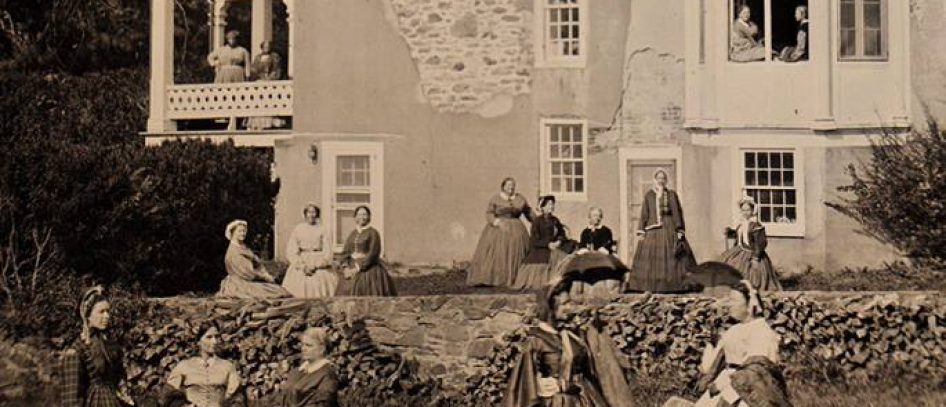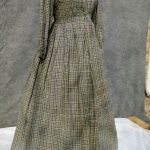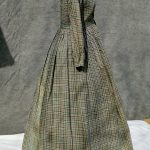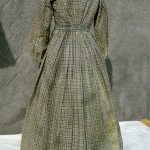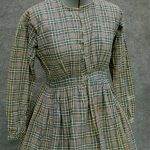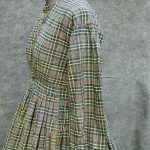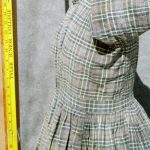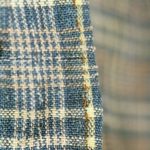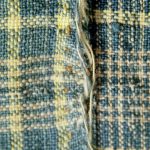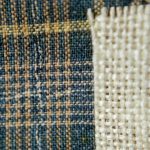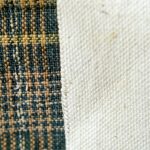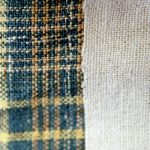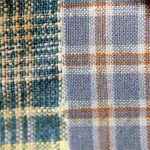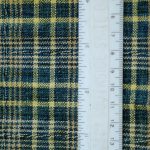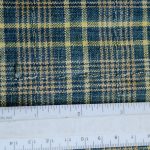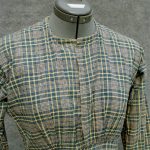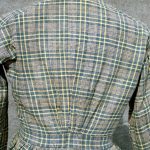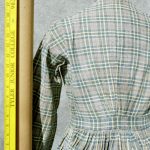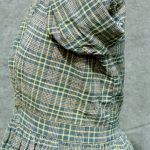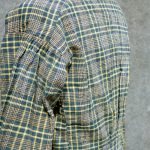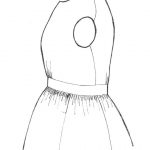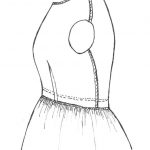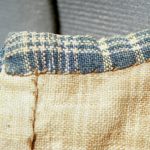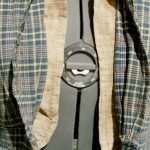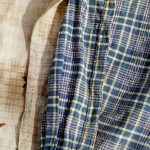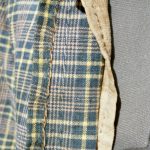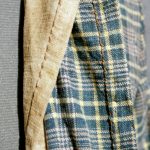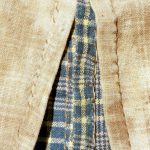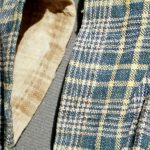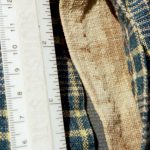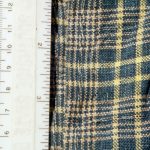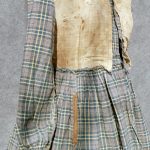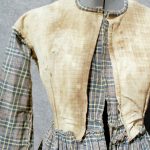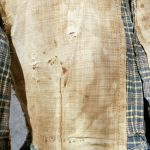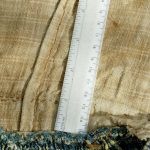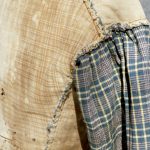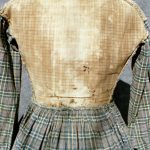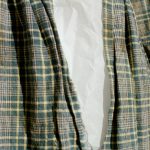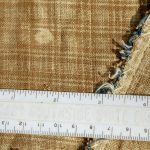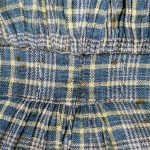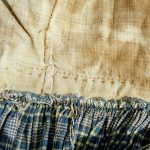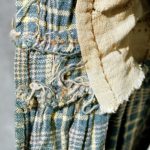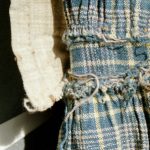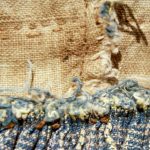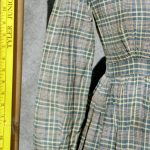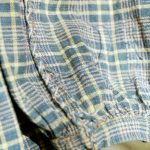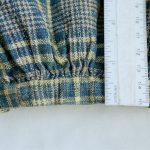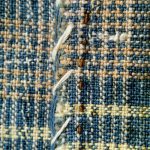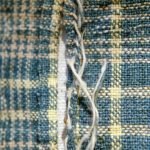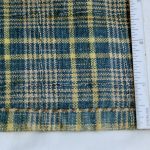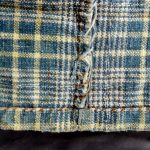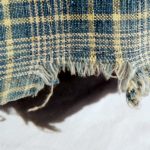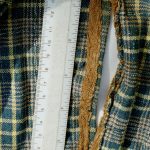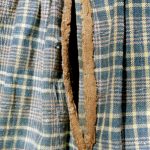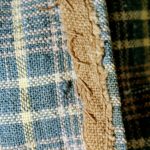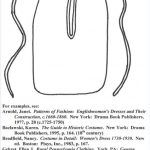This dress is owned by Vicki Betts. She has graciously allowed her photos and analysis of the garment to be included here.
[Note: All photographs are thumbnails. Click on each to restore to full size. Photographs were taken with a Canon EOS RebelX film camera, Kodak Max 35 mm, 400 ASA film, no flash, which was transferred to CD at the time of processing. They were taken outside in natural light. All measurements are in inches. The dress is shown on a dressform with a bust set at 34¼ inches, a waist of 27 inches, and a 15 inch back waist length. The dress form is shown with a 90 inch cage crinoline, but without chemise, drawers, corset or petticoat.]
This dress was purchased indirectly from the Harold Furr estate in Stanly County, North Carolina, which is forty-one miles northeast of Charlotte in the south-central part of the state. In 1860 Stanly County had a population of 7,801, of which 1,169 were slaves, and it produced 180,776 bushels of corn, 97,328 bushels of wheat, 473 bales of cotton, and 6,250 pounds of tobacco. The name of the original dress owner is unknown. She is thought to have been either a Furr or a member of Mrs. Harold Furr’s family, the Simpsons—there were many representatives of both names in the 1860 Stanly County census. It could have also come through a female line that married into the Furrs or the Simpsons.
| Bust | 35½” |
| Waist | 31¼” |
| Back waist length | 15” |
| Back shoulder length | 16½” |
| Front opening total | 23” |
| Skirt circumference | 118½” |
This is a fairly typical Civil War era homespun, handwoven, handsewn dress. It exhibits the standard Civil War era attributes of a long shoulder seam that falls toward the back as it approaches the armscye, as well as full even gathering on the skirt at the waist and a collarbone level jewel neckline. It would not be considered a “work” dress because the sleeves do not roll up nor can they be pushed up to get them out of the way for heavy, dirty chores. The weaver put a great deal of care, planning, and skill into the production of the fabric in a fairly intricate plaid. By placing the dress on a dress form, it would appear that the original owner was approximately 5’4” tall, and about a size 12 using a modern American clothing pattern company’s measurements.
The fabric is a plain woven (one over, one under) cotton, in a plaid design. There are approximately 36 threads per inch, although thread diameters vary widely and there are quite a few slubs visible and thread ends loose on the inside. Weaving instructors at Tyler Junior College suggested that the closest modern thread equivalent in diameter would be a 20/2 on average, but the threads in the dress are single ply. The threads appear to use a Z twist. There is no selvedge to speak of, and the different colored threads used in the plaid are looped down until needed again, but only on one edge of the fabric. The other edge is neat and clean.
| W. N. Watt, in Early Cotton Factories in North Carolina and Alexander County estimated that it took 360 hours to produce 30 yards of homespun fabric—160 hours to pull the cotton by hand from the seed and card it; 85 hours to spin and then hank the weft; 17 hours to gather bark, dye, size the thread and spool the warp; 12 hours to quill the weft; 10 hours to warp, beam, harness and “slew” the loom; 75 hours to weave the cloth, for a total of 36 work days of 10 hours each. If the labor is proportionate, it should take almost seven 10 hour days to produce the 5 2/3 yards of cloth for the Furr dress—30.19 hours for pulling the seed from the cotton and carding it; 16.04 hours for spinning and then hanking the weft; 3.21 hours to gather bark, dye and size the thread and spool the warp; 2.26 hours to quill the weft; 1.89 hours to warp, beam, harness and slew the loom; and 14.15 hours to weave the cloth, for a total of 67.14 hours. Betty J. Mills, in Calico Chronicle estimated that it took two weeks to spin the thread for a dress, one week to weave, and another week to cut and handsew a dress, depending on the complexity. Using 36 threads per inch, 34” wide and 5 2/3 yards long, there is roughly 498,804 inches of weaving thread in this length of fabric, or 41,567 feet, which is close to 7.87 miles. I have no estimate on sewing thread which is two ply. |
The thread count for the Furr dress matches that of the Love homespun dress at the Alabama Department of Archives and History, and is close to dresses in Austin, Raleigh, Gainesville GA, Richmond VA, Gallatin TN, Greenville SC, and Wewoka OK, each of which is within 10 threads per inch.
For comparative purposes, burlap has 12 threads per inch, very loosely woven. Canvas has 38 threads per inch, very tightly woven. A common linen/cotton blend has 40 threads per inch. Osnaburg has 44 threads per inch. Chain store “homespuns” may have 56 threads per inch.
The dress uses three main colors—blue, a fairly bright yellow, and a pinky-beige, along with two cream threads used in the center of each plaid. The dyes have not been chemically analyzed, but the blue is almost certainly indigo. There are many historic possibilities for the yellow and pinky-beige, and the latter may well have faded over time. The cream is probably undyed white cotton.
Warp threads
12 blue
4 yellow
12 blue
4 yellow
12 blue
2 pinky beige
2 blue
2 pinky beige
2 blue
2 pinky beige
2 blue
1 blue and 1 cream loosely plied and woven as a single thread
1 blue and 1 cream loosely plied and woven as a single thread
2 blue
2 pinky beige
2 blue
2 pinky beige
2 blue
2 pinky beige
Weft, or filler
10 blue
4 yellow
10 blue
4 yellow
10 blue
2 pinky beige
2 blue
2 pinky beige
2 blue
2 pinky beige
2 blue
1 blue and 1 cream loosely plied and woven as a single thread
1 blue and 1 cream loosely plied and woven as a single thread
2 blue
2 pinky beige
2 blue
2 pinky beige
2 blue
2 pinky beige
The repeat is every two inches in the warp, and every 1¾” in the weft or filler.
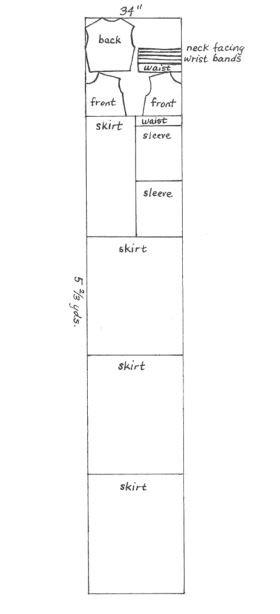
Above is a possible fabric layout for the Furr homespun dress. The width is 34”, selvedge to selvedge, and as cut in the sketch, would require 5 2/3 yards of fabric. Note that the center front bodice pieces both use the selvedge. Fabric width is wider than seen in most other homespun dresses, which averages closer to 29”. It is most similar to homespun dresses in Austin (33”) and in Atlanta (the M4 dress—32¾”).
| Bodice center back | 15” |
| Bodice back width | 16½” |
| Neckline | 17¾” |
| Side seams | 8” |
| Shoulder seams | 8¼” |
| Dart | 5” |
The fashion fabric of the bodice is in a gathered, or “O” style, which is common with period cotton dresses. Most front gathers are concentrated to 3½” sections under each breast, with most gathers beginning 1¼” from the front edge on the left and 1½” from the front edge on the right. The dress opens down the front, and has a single panel back. The shoulder seam is 8¼” long and slants toward the back as it approaches the armscye. The center back is 15” from the neckline to the bottom of the waistband. The width of each side of the bodice front is about 9½” and the width of the back is 16½”. There is no yoke, no trim, and no boning. The neckline is not piped but has a ½” wide self facing on the inside of the neckline. The facing is in three pieces and is cut on the straight of the grain. The dress has a collarbone level jewel neckline, 17¾” around, with no evidence of a collar, although a detachable white cotton collar was probably worn with it. There are no puckers in the fashion fabric around the neckline where it doesn’t lie perfectly smooth.
There are no front fastenings either in the fashion fabric or the lining, and no disturbed threads from ripped out hooks and eyes that I could find. The dress probably closed left over right judging from the small extension on the right side of the waistband and the slight difference in the width of the front bodice pieces at the waistband. The center front fashion fabric is not attached to the lining fabric—both pieces are loose from the neckline to the waist. The fashion fabric at the front opening utilizes the selvedges which are turned under 5/8” and hemstitched down with brown thread. The front bodice lining is turned, folded back 7/16” and hemstitched down. The front of the lining at the waist has been ripped back about 2” on each side. The plaids on either side of the center front do not match—they are about ½” off. The side seams of the bodice are toward the back, with the bodice measurements just above the waistband being right side 10¾”, back 10¼”, front left 10¼”. The back fashion fabric is gathered only in the center 2”. Bodice side seams are 8”.
The bodice is fully lined, with a fitted lining, similar to about one third of the homespun dresses that I’ve seen. The lining has no gathers in the back and single vertical darts 5” long on either side of the front, 3½” from the front edge of the lining. The lining fabric is a sturdy cotton in a very faded brown and cream plaid with a ¾” repeat both ways. Both the warp and the weft are:
4 brown
2 cream
2 brown
2 cream
4 brown
8 beige
This fabric is also probably handspun and handwoven, with about 32 threads per inch and a thread diameter variation similar to the fashion fabric.
Seams in the bodice are overcast with cream 2 ply thread, probably handspun. On the right side of the bodice, the top of the side seam allowance is stitched into the armscye facing the front; at the waist it faces to the back, so the seam allowance twists in between. On the left side of the bodice both the top of the side seam allowance and the bottom of the side seam allowance are stitched to face the back. Both darts in the lining are folded and stitched toward the back. The shoulder seam allowances at the neck are folded toward the back on the left, and to the front on the right. The shoulder seam allowances are free where they meet the armscye.
| Waistband around | 31¼” |
| Waistband across | 1¼” |
The waist is straight, slightly higher in the front than in the back (early pregnancy?), and 31¼” around, although the exact overlap distance is not clear since there are no closures, but could be about ½” judging by the difference in the width of the two front bodice pieces. The waistband is of the fashion fabric, which is extremely common with cotton dresses, and is made up of three pieces—15¼”, 15”, and 1¼” with the smallest piece at the front right and the two larger pieces meeting at center back. The longer pieces have their plaids matched, but the extension does not. Both center front pieces of the waistband utilize the selvedge, flush on the left side and turned under on the right. The waistband is 1¼” wide, and is lined with the lower portion of the bodice lining, similar to the Williams dress at Raleigh. Two lines of stitching are visible through to the lining on the inside, with the finer of the two lines stitched out through the waistband. Neither edge of the waistband is piped, which is uncommon.
| Sleeve length | 19½” |
| Sleeve diameter | 16” |
| Armscye | 13¼” |
| Wrist | 9” |
| Wrist binding width | ½” |
The sleeves are in the bishop, or gathered style, one piece, unlined, which is relatively uncommon in extant homespun dresses—most are coat sleeves. The sleeve pieces are rectangular, cut on the straight of the grain, with no rise at the top, judging from the plaid lines. The plaids of the sleeves are matched—each sleeve starts at the top with the same line. They are gathered into the armscye and into a ½” wide self binding at the wrist. The self-binding is also almost matched using the wider blue line of the plaid. The wrist is 9” around and has no opening. The armscye is 13¼” around. Neither the armscye nor the sleeve seam is piped, which is uncommon for the armscye but typical for the sleeve seam of the period. The armscye seam is stitched in brown thread and overcast with cream thread. The lengthwise sleeve seam is stitched with brown thread and overcast with cream thread. There is no sleeve cap and no trim. The sleeves are 19½” long and 16” around. The lengthwise sleeve seam falls directly under the arm and does not meet the side bodice seam which is slightly further to the back.
| Skirt panel length | 40½” |
| Skirt circumference | 118½” |
| Skirt panel widths | 3 panels 34” |
| 1 panel 16¾” |
The skirt is 40½” long and has a circumference of 118½”. It drapes nicely over a 90” cage crinoline. The skirt panels are rectangular—three are 34” wide selvedge to selvedge, and one is cut 16¾” wide with a selvedge on one side. The center front panel is wide, the panel to the left is narrow, and the other two panels back around to the front are wide. Each selvedge to selvedge panel starts at the center of the wider blue plaid and ends before the second yellow line of the blue plaid. All of the panels are lined up the same way. All of the selvedge edges match the plaid at at least one place in the skirt. The cut edge of the narrow skirt panel is to the front, with the selvedge edge to the back. As is typical in handwoven cloth, the plaids are not perfectly uniform in width and so are almost impossible to match the full length of a skirt. There are no tucks and no flounces.
The seam allowance in the tightly gathered top of the skirt is only ¼”. The skirt is gathered (not gauged) pretty evenly all round, with no non-gathered areas. Strangely, I don’t see a separate gathering stitch—did she pull one of the weaving threads or did she remove it? The stitching line is brown thread with the edge overcast also with brown thread. The skirt opening is in the center front, cut into the front skirt panel. The edges of the slit are hemmed down for 6¾”, narrowly on the right, and a wider placket on the left, and it is ripped down an additional 4¾”. The length of the entire front opening, neckline to bottom of hemmed section is 18¾”, and to the bottom of the rip is 23”. There is no loop at the waist band for hanging up the dress.
Seam allowances in the skirt are ¾” and the panels are handsewn together with a running stitch of five stitches per inch, brown thread. The cut skirt panel has the seam allowance overcast with cream thread, three stitches per inch, but the selvedge to selvedge panels needed no seam treatment.
The skirt is not lined and there is no skirt facing or hem braid. The skirt hem is just turned up ½”, turned up again ½” and hemstitched down with brown thread at about five stitches per inch. The same horizontal plaid line is matched all of the way around the hem.
On the left side of the skirt between the center front panel and the narrow skirt panel there is a pocket opening in the first seam, 2¾” down from the waist. The hole is 6” long, but there is no pocket there. The hole is faced with 3/8” chocolate brown binding which is overcast with the same brown thread used in the rest of the dress, so it does not appear that a pocket has been ripped out. It was possibly used with a separate pocket suspended from the waist over the petticoat. This is the first time I have seen this feature in a dress.
There are no patches in the dress, but there are a few holes. The left bodice front lining and the back bodice lining are particularly fragile. The lining also has dark brown spotty stains but the stains are not particularly associated with the holes. The bodice fabric also has some dark brown stains, possibly iron. There is a hole in the hem, about ¾” high and 2” across about where the right foot would hit, 5½” into the right side panel from the center. In two short places the skirt seams have come undone. There is a very small brown tinged hole in the left back about one inch above the waistband. There are also three small holes on the right side of the bottom of the skirt opening. The dress is slightly darker on the inside, and has a faded strip down a part of the right side of the right side panel, a little toward the hem of the skirt, as well as the bottom right edge of the center panel. The lining is faded under the arms and in the center back. The stitching threads in the armscye are brown around the top of the arm, and faded to light beige under the arm. This would add evidence to the likelihood that the dress was actually worn, rather than just using a recycled lining, despite the fact that there are no fastenings in the dress.
Vicki Betts is a native of Tyler, Texas, and is a retired librarian from the University of Texas at Tyler. While a student at Tyler Junior College she found a Civil War era newspaper article describing how the women of her community cut up their carpets to make blankets for the soldiers. That developed into long term interests in the Southern Civil War home front, historical newspapers, women’s history, and local history. As a history major at East Texas State University she completed an honors thesis on Smith County, Texas, in the Civil War which was later published. She became involved in living history and researched topics that varied from the impacts of the battles of Shiloh and Mansfield on the locals, to Southern homespun dresses and snuff dipping. Locally she has worked on the history of Camp Ford POW Camp and the Civil War letters of William and Mary Herndon. As an active member of the Smith County Historical Society she has presented programs on Rosenwald Schools, women suffragists, professional wrestling, chicken free-range and goo-goo eyes city ordinances, dissent during World War I and the organization of the first women’s labor union, and the integration of Tyler State Park. She has two articles in edited collections—“A Sacred Charge Upon Our Hands: Assisting the Families of Confederate Soldiers in Texas, 1861-1865” in The Seventh Star of the Confederacy (2009), and “Everyone Has the War Fever: Anglo Texas Women Prepare for Secession and War” in Women in Civil War Texas (2016).
